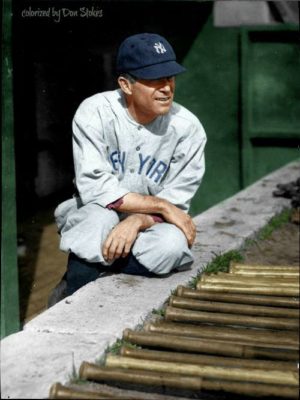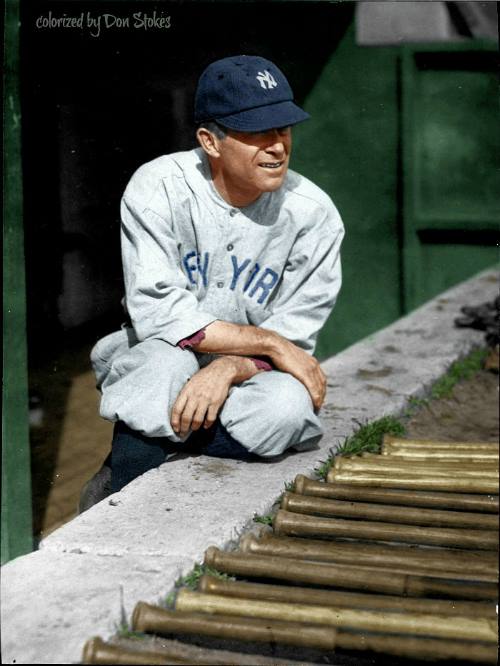Subscribe to our blog for automatic updates and Free Bonus Reports: “Memorable World Series Moments” and “Gary’s Handy Dandy World Series Reference Guide.”
Babe Ruth Collectibles on Amazon Baseball Books on Amazon
Miller Huggins Photo Gallery
Click on any image below to see photos in full size and to start Photo Gallery:

Spotlight on the Hall-of-Fame: The Great Yankee Manager, Miller Huggins
“Hug was the only man who knew how to keep me in line.” –Babe Ruth, speaking of Miller Huggins
“Miller Huggins was one of the greatest managers I have ever met.”-Sportswriter and Hall-of-Fame umpire Billy Evans
“Sure I’m lucky… to have played six years for that wonderful little man, Miller Huggins…” –Lou Gehrig, mentioning Miller Huggins in his “Luckiest Man” Farewell Speech, July 4, 1939
Miller Huggins was unquestionably one of the great managers in baseball history. In 17 seasons (1910-1929), over 2570 games, his teams posted a 1413-1134 record (.555) with 23 ties. His 1413 wins ranks 23rd all-time. His first five years were less-than-stellar with the Cardinals. Probably his most notable accomplishment during this period was helping a young Rogers Hornsby with his batting stance. Things changed once he got to the Yankees in 1918. His teams went 1067-719 (.597) with six pennants and three World Series championships within a eight-year span.
In the featured photo below, we see a beautiful colorization of Miller Huggins by our resident baseball artist, Don Stokes.
“Hug,'” as he was affectionately called by friends and many of his his players, learned much of his managing strategy at the hands of Hall-of-Fame manger Ned Hanlon and later, Roger Bresnahan. He at first emphasized “small ball” and baseball fundamentals, characteristic of the Dead Ball Era. Of course, that all changed on a day in 1920 when a highly touted young player named Babe Ruth showed up in his Yankee clubhouse.
The cerebral Huggins earned a law degree from the University of Cincinnati but realized he could make more money playing baseball. One of his professors, William Howard Taft, the eventual 27th President of the United States, advised him to pursue this more promising career path. Over his 13-year playing career (1904-’16), with the Reds (1904-’09) and Cardinals (1910-’16), the compact, 5’ 5”, 140 pound speedster inspired nicknames like “Mighty Mite,” “Rabbit” and “Little Everywhere.” An excellent leadoff man and defensive second baseman, he compiled a .265 batting average with a career .382 on-base percentage, leading the league in walks four times, and scoring 100 or more runs three times. He also had 324 lifetime steals, and posted a career .965 fielding average. Baseball historian Bill James ranked Huggins as the 37th best second baseman of all time.
When the underachieving Yankees were looking for a new skipper in 1918 to replace “Wild Bill” Donovan, American League president Ban Johnson recommended Huggins to owner Jacob Ruppert. Impressed by Huggins’ baseball acumen, Ruppert offered him the job in spite of reservations expressed by partner Tillinghast Huston who preferred drinking buddy Willard “Uncle Robbie” Robinson. This drove a wedge between the two owners that culminated in Huston selling out to Ruppert in 1922.
Finishing fourth his first year at the Yankee helm, Huggins then commenced on his effort to remake the Yankee roster. An excellent judge of baseball talent, he brought in such stars as Ernie Shore, Dutch Leonard, and Duffy Lewis. The next year saw the arrival of Waite Hoyt and Wally Schang, followed shortly by Aaron Ward, Wally Pipp, and Bob Shawkey. Huggins found himself on the hot seat entering the 1921 season, but winning the pennant that year – the first in the team’s history – silenced his critics. They lost to their cross-town rival Giants in the first all-New York Fall Classic.
Roster moves continued in 1922, bringing Johnny Mitchell, Everett “Deacon” Scott, “Bullet Joe” Bush, and “Sad Sam” Jones. With these moves came a second pennant – and a second World Series loss to the Giants. The improvement was sustained as the Yankees won their third consecutive pennant and their first World Series championship in 1923. This year also saw the arrival of Ed Barrow who eventually became the architect of one of the greatest dynasties in baseball history.
After finishing fourth in 1924, and then falling to seventh after 42 games in 1925, Huggins’ job was again in jeopardy. More changes were in order, the most notable being the replacement of Wally Pipp at first base with Lou Gehrig who then started on his “Iron Man” consecutive games streak. During the slide, Huggins received a vote of confidence from Ruppert: “Miller Huggins will be manager as long as he cares to be,” as the Yankees finished seventh in the eight-team league. The team rebounded in 1926 with another pennant, but suffered a loss to the Cardinals in the World Series in seven games. 1927 saw the advent of “Murderer’s Row,” a record 110 win season, and a second World Series championship. With the arrival of Bill DIckey in 1928, another pennant followed and an easy four game World Series sweep over the Cardinals.
Huggins’ repeated confrontations with Babe Ruth are well known. The Babe resisted Huggins’ attempts at discipline and did not respect him, it’s said, due to his small stature and soft-spoken nature. Huggins, in turn, wasn’t intimidated by his star player who just happened to be about twice his size. In one memorable altercation, Huggins suspended Ruth indefinitely on August 29, 1925 for “misconduct off the playing field,” and fined him $5,000. Ruth responded he would “never play for Huggins again.” To the Babe’s surprise, Col. Ruppert sided with Huggins, confirming that Ruth would be suspended for” as long as the manager sees fit.” After apologizing to both Huggins and Ruppert, a contrite Babe Ruth was reinstated on September 5.
Huggins fell ill on September 20, 1929 with an infectious disease called erysiplas and checked into Saint Vincent’s Catholic Medical Center where he received blood transfusions. He died five days later, aged 51. The American League canceled its games the following day as thousands of tearful fans paid their respects at Yankee Stadium. A moment of silence was held before the start of Game Four of the 1929 World Series. The Yankees dedicated a monument to Huggins on May 30, 1932, placing it in front of the flagpole in center field in Monument Park. Miller Huggins was elected to the Hall of Fame in 1964.
-Gary Livacari
Visit our On-Line Sports Memorabilia Store
Photo Credits: The beautiful featured photo colorized by Don Stokes. Click on link to visit his Facebook page. All others from Google search
Information: Excerpts edited from the Miller Huggins Wikipedia page.
Statistics from Miller Huggins page on Baseball Reference
Subscribe to our blog for automatic updates and Free Bonus Reports: “Memorable World Series Moments” and “Gary’s Handy Dandy World Series Reference Guide.”
“We are a participant in the Amazon Services LLC Associates Program, an affiliate advertising program designed to provide a means for us to earn fees by linking to Amazon.com and affiliated sites.” Click here to view Amazon’s privacy policy

